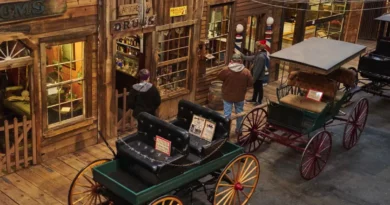Sarah Burton Goes Missing in Joplin Missouri
Joplin sits at the seam of rolling Ozark foothills and flat river plains, a city whose streets feel familiar to anyone raised in the Midwest. On the night of July 16, 2018, the familiar cracked. Sarah Elizabeth Burton, a 28 year old Joplin woman, moved through a handful of ordinary places around town and then vanished. The hours that followed turned into days, the days into years, and the city learned the specific ache that comes when a neighbor is missing and answers do not arrive. This account lays out what is known, what investigators and volunteers have done, and why the case remains solvable if the right voice speaks or the right fragment of physical evidence is reexamined with modern tools.
The person at the center of the story
Sarah was a daughter, a friend, and a young woman navigating a difficult stretch of life while still tethered to family. She was about 5 feet 7 inches tall with brown hair and blue eyes. People close to her describe a quick smile and an easy way with conversation, even when circumstances were hard. She had known challenges, and she had also shown the kind of resolve that tells you a person intends to come back home at the end of the day. Those who knew her emphasize a steady line through the ups and downs. She checked in, she looked out for family, and she had plans that stretched beyond July 2018. A profile like that matters in a missing person case because it informs the question at the heart of every disappearance. Did she choose to leave, or did something force the choice upon her.
The city blocks that frame the last movements
Several places in Joplin form the stage for the last hours that can be reasonably fixed. The intersection of 10th Street and Rex Avenue recurs in reports as a point where Sarah was dropped off around midnight between late July 16 and the early minutes after. That corner sits in a residential slice of the city where late night movement is quiet and the glow of porch lights does most of the work. The distance from there to north and northwest neighborhoods is short by car and walkable by foot in the mild air of a Missouri summer night. The ordinary nature of the setting matters. The streets do not announce themselves with neon. There are no natural choke points that hold strangers in place. One turn takes a person out of sight.
The final evening that can be placed in time
The simplest narrative is the one that investigators kept returning to as they cross checked statements and phone activity. On July 16, 2018, Sarah spent time with acquaintances and then accepted a ride. She was dropped near 10th Street and Rex Avenue shortly after midnight with the stated plan of heading toward family later that morning. Some accounts place a subsequent sighting at a residence in the northern part of the city in the early daylight hours of July 17. After that, nothing that can be verified by video or transactional records. There is no confirmed call or text that fixes her after those early hours. There is no bank activity that plants her in a store. The line goes quiet.
The first days of search and the change in posture
When a daughter does not return a parent notices quickly. Sarah was reported missing on July 20, 2018, when hours of silence became days. Joplin police began the work that forms the backbone of any modern missing person inquiry. They took statements from people who were with her on July 16. They canvassed the neighborhoods around 10th and Rex and along routes leading toward the north side. They traced phone activity and looked for camera footage from businesses and private residences. With assistance from state and federal partners they expanded the search to include properties outside the city limits when tips supported the effort. Within that first stretch of work the case clearly moved from a simple missing report to a suspicious disappearance that warranted sustained attention.
The search locations and what they yielded
In the months after July 2018 several places became focal points. A residence in northwest Joplin drew intensive interest based on statements and a reported later sighting. When investigators search a home and nearby lots in a case like this they look for things that normal eyes might miss. Disturbed soil. Cut vegetation that does not match the season. Items that do not belong to a resident. In 2019 leads carried the search to a property in Newton County and a nearby body of water. Divers and technicians recovered items that were evaluated but no public statement linked them conclusively to Sarah. To an outside observer that might sound like failure, but in real investigations negative results still move the ball. They eliminate places, narrow maps, and change the incentives for people who know more than they have said.
The evidence that shapes the most likely scenarios
Three facts give the case its shape. First, the last drop off near 10th Street and Rex Avenue was late at night, a time that reduces potential eyewitnesses and limits open businesses with cameras. Second, there is a reported later sighting at a private residence the same morning, which, if accurate, shifts the last known point from a street corner to an indoor space where someone had the ability to restrict movement or to conceal what happened. Third, there has been no valid communication from Sarah since that time. When those elements are placed together, the weight of probability leans toward an event that occurred within a small circle of people and places, rather than a random encounter on an open street.
Theories and how to think about them
There are two broad theories that recur. The first is that Sarah left the drop off, met up with someone she knew at the residence in question, and was harmed there or shortly thereafter. The second is that she made it to that residence, left on foot later in the morning, and encountered harm in the neighborhood or while moving toward another location. The first theory better accounts for the absence of reliable sightings in daylight and for the urgency with which investigators focused on specific properties. The second cannot be fully dismissed because absence of evidence is not evidence of absence. A disciplined view keeps both possibilities in play while asking what each demands in terms of opportunity, motive, and the ability to hide consequences.
How families and communities keep a case alive
The most reliable engine for forward motion in a cold case is not luck. It is persistence. Sarah’s family has kept her name in front of the public and kept lines of communication open with investigators. They have shown up for interviews and appeals. They have worked with community groups that organize searches and awareness events. In practical terms that pressure ensures that any new lead receives timely attention. In human terms it reminds anyone with withheld knowledge that silence is an active choice that carries a moral cost. Communities contribute by repeating basic facts, by avoiding rumor, and by supporting efforts that produce actionable information rather than noise.
What investigators can still do today
Time changes the toolbox. In 2018 canvassing for cameras was already standard, but private surveillance coverage of residential areas was thinner than it is now. If any devices or drives were preserved, modern processing can sometimes pull clearer frames out of noisy footage. Items recovered in earlier searches can be reexamined using techniques that were not practical in 2018. Touch DNA methods are now more sensitive. Soil and pond sediment analysis can be more finely tuned. If a suspect list exists, contemporary genetic genealogy might narrow it. Even without new lab work, a structured reinterview of every person who saw Sarah on July 16 can surface contradictions that did not register the first time. People forget details they invent. People remember details they lived.
The role of digital traces
Cellular records from 2018 exist in a different technological landscape than today, yet they still hold value. Tower hits, timing advance, and sector coverage can be modeled against modern maps to refine likely travel paths. If devices belonging to associates were active that night, overlapping movement can be compared. Messaging platforms leave metadata that may have survived on remote servers even when local devices were wiped or replaced. Investigators who pair a modern digital reconstruction with old fashioned door knocking sometimes find a hinge they did not expect. A five minute overlap in the wrong place tells a story that a witness needs to explain.
Why the case is still solvable
Cases with shorter last known windows and smaller location sets are inherently solvable. Sarah’s case has both. The relevant places in Joplin number in the single digits, not the hundreds. The set of people who interacted with her in the hours before she disappeared is countable. There were searches, and although they did not deliver a resolution, they created a map of where not to look. Rewards have been offered, which adds a practical reason for a marginal witness to come forward. Most importantly, time does not make facts less true. A person who was present in 2018 is older now. Relationships change. The calculus of risk changes. The right conversation at the right moment can open a door that was shut seven years ago.
A call to conscience and a practical request
If you were with Sarah on July 16, 2018, or in the early hours that followed, and you have withheld a detail because you thought it would not matter, consider that it may matter now. If you once told a partial truth to protect a friend, remember that a friend who asks you to carry that kind of weight is not worthy of protection. If you live in a home that was part of that morning and you noticed something out of place in the days that followed, it is not too late to tell someone. Even the shape of a trash pickup, a vehicle that moved at an odd time, or a phone that went dark for an hour can make a difference when combined with other data.
Closing reflection
On July 16, 2018, a woman trusted that the city she knew would carry her safely through the night to the morning. The streets she walked and the rooms she entered were not strangers to her. That is part of why her disappearance stings. It says something went wrong in a familiar place among familiar people. The record we can assemble is simple and unsatisfying. A drop off near 10th Street and Rex Avenue. A reported sighting at a residence hours later. A silence that has lasted ever since. Somewhere in that short chain lies the truth. It can still be found. When it is, a family will gain the chance to trade a question for an answer, a city will feel a measure of relief, and the story of a woman named Sarah Elizabeth Burton will regain the dignity of a known ending.
Discover more from City Towner
Subscribe to get the latest posts sent to your email.




